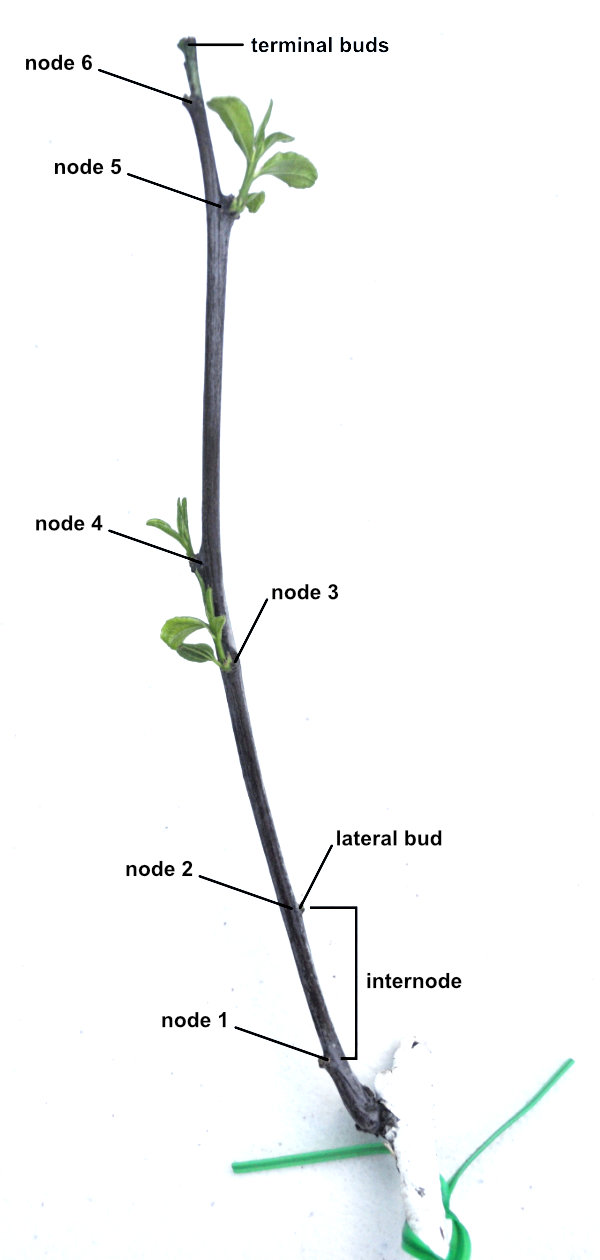Photo Journal: Jujube Tree Buds and Branch Development 1
Last week we covered the location of jujube tree nodes and the two types of buds present at each node. (That post has since been updated to include a crash-course description of the branch types as well.) The post ended with a summary of what each bud type could develop into, and the promise of an attempt to predict what each active bud on the 2020 Ta-Jan blogging tree was likely to develop into.
Let’s delve in!
Here is the same photo from last week, with six nodes and the terminal buds labelled:

© Optimate Group Pty Ltd
(There is another node below node 1 — node 0 we can call it — where the trunk meets the white tape, but I’m ignoring it here, as it won’t feature in this ongoing discussion of tree development.)
But before looking at each node, let’s first step back and examine the trunk as a whole, as this will help with our bud investigation. If you’re new to all of this, please just take my word for it for now — but when you know what you’re looking at, it’s clear that this trunk is a permanent branch extending from a fruiting mother branch. Only two types of branch arise from a fruiting mother branch: fruiting branchlets (predominately), and permanent branches (occasionally). Fruiting branchlets are thin and deciduous; permanent branches are thick and, well, permanent! And this one is very much permanent.
(The fruiting mother branch in the photo is mostly obscured by the white tape. It is not intuitively or obviously a ‘branch’, as it looks nothing like one! We’ll cover this branch type in more detail in a future post, or you can read up on it and the other types now here and here.)
A very strong main bud in that fruiting mother branch had broken dormancy last season to produce that permanent branch, which has now become the main trunk of this new little tree.
Now that we know we are examining buds on a permanent branch, we know to focus on Main Buds on Permanent Branches and Secondary Buds on Permanent Branches, so let’s really begin!
The photo above of the trunk was taken on the 24th September, 2020. The photos below are of close-ups at each of those nodes, twelve days later on the 6th October (yesterday).
Node 1

© Optimate Group Pty Ltd
The solitary secondary bud possibly grew a fruiting branchlet in its first (and only) year while the adjacent main bud developed a fruiting mother branch during that time. The fuzzy cluster above is of emerging fruiting branchlets from secondary buds within that mother branch. The main bud in this case is a weak main lateral bud and the secondary bud was possibly a weak secondary bud.
Node 2

© Optimate Group Pty Ltd
The main bud is dormant while the secondary bud looks to be developing a fruiting branchlet or possibly a secondary branch (I think a fruiting branchlet is more likely, but we’ll see soon enough!). The main bud in this case is a strong main lateral bud and the secondary bud is likely to be a weak secondary bud.
Node 3

© Optimate Group Pty Ltd
This one is a young fruiting mother branch with one fruiting branchlet already emerging, and visible is a secondary bud within the mother branch forming another branchlet. Alongside is the remains of a removed secondary branch, which had developed from a secondary bud. The main bud in this case is a weak main lateral bud and the old secondary bud would have been a strong secondary bud.
Node 4

© Optimate Group Pty Ltd
Node 4 is similar to node 3, with a removed secondary branch and a young fruiting mother branch growing fruiting branchlets.
Node 5

© Optimate Group Pty Ltd
Node 5 is similar to nodes 3 and 4, with a removed secondary branch and young fruiting mother branch growing fruiting branchlets.
Node 6

© Optimate Group Pty Ltd
Node 6 shows a dormant main bud and an active secondary bud that looks like a fruiting branchlet is on the way. (Again I feel this more likely than a secondary branch, but time will tell!)
Terminal Buds

© Optimate Group Pty Ltd
This section here is showing all the signs of preparing to send out an extension branch with attached fruiting branchlets. Making this a strong main bud with many secondary buds. I’ll write more about this when it happens, and will leave this as the subject of a future post!
About the Author
BSc(Hons), U.Syd. - double major in biochemistry and microbiology, with honours in microbiology
PhD, U.Syd - soil microbiology
Stumbled into IT and publishing of all things.
Discovered jujube trees and realised that perhaps I should have been an agronomist...
So I combined all the above passions and interests into this website and its blog and manuals, on which I write about botany, soil chemistry, soil microbiology and biochemistry - and yes, jujubes too!
Please help me buy a plant if you found this article interesting or useful!